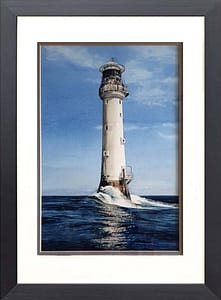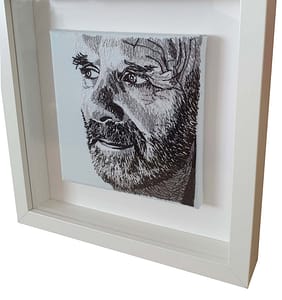Choosing a frame can be a difficult task.
“It's funny how the beauty of art has so much more to do with the frame than the artwork itself.”
― Chuck Palahniuk, Choke.
Of course I don’t necessarily agree with this statement, I’d be out of a job if I did! However, it is true that a picture frame is nearly as important as the artwork itself.
The choices you make have the potential to beautifully enhance or woefully diminish the impact of a painting.
How you frame an artwork is one of the most important decisions you need to make. Being a professional artist who undertakes many commissions, choosing a frame is a topic I am constantly asked to give advice about. ‘Can you tell me what type of frame to use?’ ‘What colour do you think I should choose?’ ‘Should I use glass?’ Some questions have simple answers. There are do’s and don’ts which will depend on what type of painting you are framing. A watercolour should always be behind glass, an acrylic or oil painting can be glazed or unglazed.
As to the choice of frame design and colour, many factors come into play.
Types of frames
There are a myriad of choices when it comes to types of frames and the choice can be daunting. You are not alone in being overwhelmed with choosing a frame which is the perfect colour, style and width. I am always racked with indecision when picking a frame for a painting. I have spent an inordinate amount of time at the framers selecting, discarding, and re-selecting a frame until I’m satisfied with my choice. Not to mention the type and colour of the mount to be chosen too! Options for choosing a frame for a watercolour or drawing will be different to those for an acrylic or oil painting.
Gallery Frames

These are the classic frame choice for many artworks – they include a mount which gives the painting or drawing space and include glass. This enhances the image and effectively creates a frame within a frame. You can choose a single or double mount. Classic ivory tends to display images to the optimum, or you might choose a coloured mount if you want a more dramatic finish. Single mounts are often used for prints. Double are often used for paintings and drawings. This style of frame is the choice for watercolours and drawings which must be protected from damp by glass.
Box Frames
 Box frames are mainly used for displaying 3-D works as they are a deeper frame with space between the glass and the mount. You wouldn’t normally opt for one of these for a flat artwork like a watercolour painting. However, you could if you particularly liked this style. They can work well for displaying a small canvas. I have used this style of framing for an embroidered portrait. This needed the protection of glass and also the depth of a box frame to accommodate the raised surface of the textile.
Box frames are mainly used for displaying 3-D works as they are a deeper frame with space between the glass and the mount. You wouldn’t normally opt for one of these for a flat artwork like a watercolour painting. However, you could if you particularly liked this style. They can work well for displaying a small canvas. I have used this style of framing for an embroidered portrait. This needed the protection of glass and also the depth of a box frame to accommodate the raised surface of the textile.
Canvas Floater Frames

Acrylic and oil paintings look best when framed: the artwork is enhanced and without they can look slightly ‘unfinished’. There are several options available when choosing a frame for these types of paintings. The choice often comes down to personal preference and budget. Acrylic and oil paintings are painted onto stretched canvas. There are two types; deep frame and narrow frame. Deep edged canvas (known as box canvas) can be left unframed for a contemporary look. The edges are usually painted with the artwork continuing around the sides. Paintings stretched onto standard canvas require framing.
A floater frame is like a tray into which the canvas is slotted. This type of frame has a space between the surround and the artwork, thereby giving the appearance of the canvas ‘floating’ within it. The frame doesn’t actually come into contact with the sides of the painting and there is no glass. Both standard width and deep-edged canvas can be framed with a floater frame.
Traditional Frames

Another option for acrylic and oil paintings is a traditional frame which slightly overlaps the front of the canvas. This is similar to the gallery frame but with no mount or glass. When I say traditional, I don’t necessarily mean a frame that looks antique. A sleek contemporary moulding can be used for the traditional frame technique. Often a second, narrower frame is used inside the main moulding to create a spacer between the artwork and frame. I would recommend this option, especially for larger works as it has the same effect as a mount in a glazed frame.
You could opt to glaze a work on canvas but this is more unusual. It's generally not required as acrylic and oil paintings are varnished which offers protection.
How do I choose the best design of frame?
When choosing a frame should you match the frame to your interior or to the painting? This is a difficult one to answer definitively as there are pro’s and con’s to both approaches. A frame is ultimately there to protect and display your painting to its best.
The most important consideration is to make sure your choice of frame suits and enhances the painting.
Style
However, taking your interior style into consideration is important as you ultimately have to live with the painting and its frame. If you live in a traditional home with antique furniture you may wish to choose a moulded gilt frame to suit this style. Equally if your house is decorated entirely in white you might not consider any other colour of frame than white to match. However, a modern monochrome painting or a large cropped modern portrait may not look its best in a gold gilt frame, even though this fits in with your interior style.
When taking your interior decoration into account, a far better approach is to consider choosing a frame which will reflect the character of your interior if this is important to you. By this I mean looking at more traditional mouldings for an older style interior. However this does not necessarily mean only considering a mahogany brown frame if all your furniture is mahogany. If your room is white washed and minimalist then a more traditional moulding could stick out like a sore thumb, but a pure white frame isn’t going to look good either. A modern sleek red frame will be a statement! (If it suits the artwork of course)
Colour
So now that you have decided to maybe limit your choices to either modern or traditional, your foremost consideration has to be what will complement and enhance the art. You may love mahogany frames but dark brown is not going to display a pencil drawing to its best advantage. A charcoal grey moulding however, will. So if you like a more traditional look you would maybe choose a pewter or charcoal moulded frame. The modern interior choice could be a plain flat profile in charcoal. Both options will match the artwork (the most important factor) but still fit in with your chosen living style.

Another viewpoint is to simply choose the frame which you like which enhances the artwork and not worry about it matching your interior ‘look’. Variety is the spice of life and why should all your frames match each other? Original art is unique and most people have an eclectic collection (I know I do). So embrace diversity and just pick that frame which best suits the art.
Show me the money – the cost of good framing
When it comes down to it, most of us love a bargain. Who doesn’t leave a shop on a high when you discover you have bought a designer outfit for half price? When it comes to choosing a frame for an expensive piece of art - let’s face it, a bespoke commissioned portrait isn’t cheap – you need to leave this love-a-bargain mentality behind. It really is a case of you get what you pay for. The difference between an off-the-shelf frame from a department store and a frame made to order from a listed framer of the Fine Art Trade Guild is like chalk and cheese.
If you have the budget, get the best frame you can.
Ready-made frames
There are a myriad of options available to you, each with their own price tag. At the bottom end is the ready-made frames which come in standard sizes and colours. There is nothing wrong with these, they are easy to source and are great for mass produced prints and photos which are also standard sizes. Prices vary but you can probably get a half decent frame for £20. I wouldn’t recommend these for an original painting if you can avoid it. Paintings are often non-standard dimensions and finding a frame with the correct mount aperture is tricky. These frames often have gaps in the mitred corners and the glass is thinner and sometimes has flaws in it.
Mid-price framers
Then there are many mid-priced framers who will mount and frame your painting for you. They usually have a wide range of mouldings and colours and you should be able to find several options that will work well with your artwork. Prices will obviously depend on the size of your painting and the frame you choose, but you should be able to source something in the region of £50 - £100 for a medium sized artwork.
Fine Art Trade Guild Framers
 At the top end of the scale are the framers who are members of the Fine Art Trade Guild. To be in the guild they have to meet very high standards and you should be assured of a top-notch service and a superior product. Alongside the usual range of frames on offer, they will have a range of very beautiful (and expensive) mouldings to choose from. If like me you have impeccable taste, you will inevitably pick out the most expensive designs! They will also have superior mounting options on offer; whitecore mountboard, conservation mountboard and cotton museum mountboard. Expect to pay anything from £200 upwards but bear in mind you will be getting a really fantastic frame.
At the top end of the scale are the framers who are members of the Fine Art Trade Guild. To be in the guild they have to meet very high standards and you should be assured of a top-notch service and a superior product. Alongside the usual range of frames on offer, they will have a range of very beautiful (and expensive) mouldings to choose from. If like me you have impeccable taste, you will inevitably pick out the most expensive designs! They will also have superior mounting options on offer; whitecore mountboard, conservation mountboard and cotton museum mountboard. Expect to pay anything from £200 upwards but bear in mind you will be getting a really fantastic frame.
Rachel is a professional artist specialising in portraiture. A graduate of Glasgow School of Art, her career over the last 30 years has included painting, teaching and lecturing, and freelance designing. She has exhibited at the Royal Scottish Academy and in 2020 was a finalist in the Scottish Portrait Awards.
-
If you haven't had a reply within 24 hours please check your junk folder






